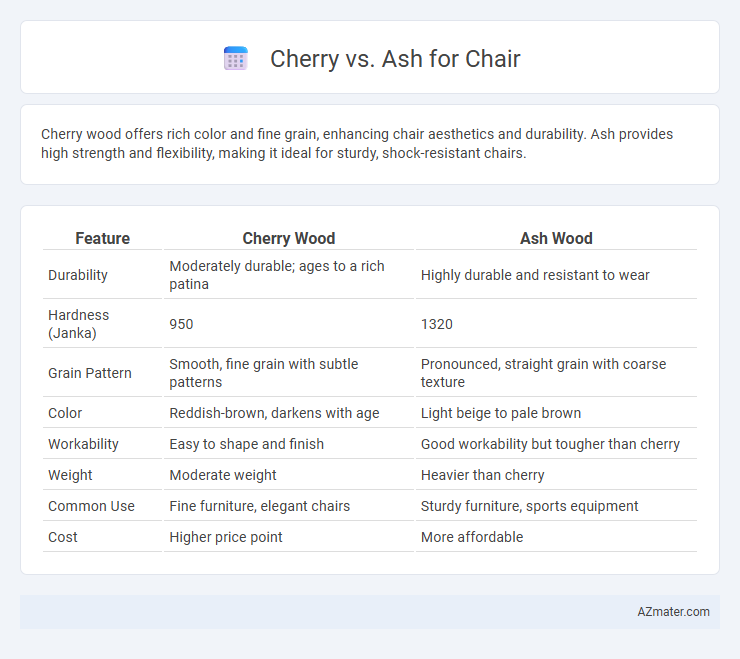Cherry wood offers rich color and fine grain, enhancing chair aesthetics and durability. Ash provides high strength and flexibility, making it ideal for sturdy, shock-resistant chairs.
Table of Comparison
| Feature | Cherry Wood | Ash Wood |
|---|---|---|
| Durability | Moderately durable; ages to a rich patina | Highly durable and resistant to wear |
| Hardness (Janka) | 950 | 1320 |
| Grain Pattern | Smooth, fine grain with subtle patterns | Pronounced, straight grain with coarse texture |
| Color | Reddish-brown, darkens with age | Light beige to pale brown |
| Workability | Easy to shape and finish | Good workability but tougher than cherry |
| Weight | Moderate weight | Heavier than cherry |
| Common Use | Fine furniture, elegant chairs | Sturdy furniture, sports equipment |
| Cost | Higher price point | More affordable |
Introduction to Cherry and Ash Wood
Cherry wood is renowned for its rich, reddish-brown color that deepens with age, offering a warm and elegant appearance ideal for high-quality chairs. Ash wood features a light blonde hue with a prominent grain pattern, prized for its strength, flexibility, and shock resistance, making it a durable choice for seating furniture. Both woods provide excellent workability and finish well, but cherry offers a more refined aesthetic while ash emphasizes robustness.
Key Characteristics of Cherry Wood
Cherry wood features a rich, warm reddish-brown color that deepens with age, providing an elegant and timeless appearance for chairs. Its fine, straight grain and smooth texture make it highly workable, resulting in durable, comfortable seating with a refined finish. Cherry is also prized for its natural resistance to wear and subtle luster, enhancing both the aesthetic and longevity of furniture compared to the lighter, more textured ash wood.
Key Characteristics of Ash Wood
Ash wood is renowned for its exceptional strength, durability, and elasticity, making it an ideal choice for chair construction that requires both resilience and comfort. Its light color and pronounced grain pattern create a visually appealing, natural look that complements modern and traditional furniture styles alike. Compared to cherry, ash offers superior shock resistance and flexibility, ensuring long-lasting performance in high-use seating applications.
Grain Patterns and Aesthetic Appeal
Cherry wood features a fine, straight grain with occasional subtle waves and rich reddish-brown hues that deepen over time, enhancing its warm and elegant aesthetic appeal for chairs. Ash wood showcases pronounced, bold grain patterns with a lighter, creamy color, offering a modern and airy look that highlights natural texture. The choice between Cherry and Ash for chair construction depends on the desired style--classic sophistication with Cherry or contemporary vibrance with Ash.
Strength and Durability Comparison
Cherry wood offers moderate strength with a Janka hardness rating of 950, providing a smooth finish and good resistance to wear, making it suitable for chairs with elegant design preferences. Ash wood ranks higher in strength and durability, with a Janka hardness of approximately 1320, known for its excellent shock resistance and flexibility, ideal for chairs that require robust support and long-lasting use. The denser grain of ash contributes to superior impact resistance compared to cherry, enhancing the chair's lifespan under heavy or frequent use.
Workability and Crafting Ease
Cherry wood offers excellent workability due to its fine grain and smooth texture, allowing for precise carving and shaping ideal for chair crafting. Ash provides superior crafting ease with its high strength-to-weight ratio and flexibility, making it particularly suitable for steam bending and creating ergonomic chair designs. Both woods are favored for durability, but Cherry tends to produce a richer finish, while Ash is preferred for functional, lightweight construction.
Cost and Availability Factors
Cherry wood tends to be more expensive than ash due to its rich color and fine grain, which are highly sought after in premium furniture markets. Ash is more readily available and generally less costly, making it a popular choice for budget-conscious consumers and mass production. Both woods offer durability, but the price difference often hinges on regional sourcing and market demand fluctuations.
Color, Aging, and Finish Options
Cherry wood boasts a rich, warm reddish-brown color that deepens and darkens with age, developing a smooth patina, while Ash offers a lighter, pale beige to light brown tone that tends to bleach slightly over time. Cherry is prized for its ability to take on a glossy finish, enhancing its natural hue and grain, whereas Ash, with its open grain, is well-suited for both clear and stained finishes, offering versatility in texture and appearance. Both woods provide durable options for chairs, but Cherry's aging process results in a unique and darker character, contrasting Ash's more neutral and contemporary look.
Environmental Impact and Sustainability
Cherry wood is moderately sustainable due to its slower growth rate and regional availability, resulting in a moderate carbon footprint during harvesting and processing. Ash wood grows faster and is often sourced from managed forests with renewable practices, making it a more ecologically favorable option with lower environmental impact. Both woods require responsible sourcing to minimize deforestation, but ash generally offers better sustainability credentials for chair manufacturing.
Best Choice: Cherry or Ash for Chairs
Cherry wood offers a rich, warm tone with fine grain and excellent durability, making it an ideal choice for elegant, long-lasting chairs. Ash wood stands out for its strength, light color, and shock resistance, providing a more affordable and sturdy option for high-traffic seating. The best choice depends on desired aesthetics and usage: cherry suits refined, classic designs, while ash excels in robust, casual furniture.

Infographic: Cherry vs Ash for Chair
 azmater.com
azmater.com